What is (EPF) Employee Provident Fund, EPF Applicability, Rules & Regulations?

Employees' Provident Fund is a scheme to save money for retirement. Both employers and employees contribute to this plan. EPF India is one of the world's largest retirement benefit schemes. It deals with many tax-related calculations that ensure employee security on or before retirement. Check out its details below.

Table of Contents

What is PF (Provident Fund) in Salary and How Does it Work?
The provident fund (PF) is a retirement benefits program intended to give salaried professionals enough money in retirement. The amount withheld from an employee's monthly income and placed into their PF account is a joint contribution from employers and employees.
It accumulates over time to become a substantial sum that the worker can use at retirement. All corporate entities with more than 20 employees are required to register for an employees' provident fund.
The program includes all corporate businesses with more than 20 employees. Though there are various exclusions and limitations, it applies to certain businesses with at most twenty employees.
For example, if a company employs less than twenty people and works in the jute, coir, beedi, brick, or guar gum industries, its contribution will be 10% lower. Every year, the EPFO reviews the EPF interest rates.
The organisation determines the interest rate on each month's closing balance and the entire year following the interest rate announcement, which is essential information for anyone learning how to compute provident fund (PF) amounts.
What are the Types of PF?
The type of work you do may determine which provident funds you qualify for. An overview of India's most popular provident fund options are:
1. Statutory Provident Fund
It is mainly meant for government workers, colleges, other recognised educational institutions, railroads, and other designated organisations.
Contributions made by qualified workers to the SPF or GPF account are rewarded with interest at a government-set rate. This pricing could change from time to time. As of November 2022, the interest rate is 7.10% a year.
2. Recognised Provident Fund
Employees of private companies employing more than 20 people are eligible for this provident fund. Here, businesses and establishments can join an already-existing, government-approved program or create their own PF trust. If an organisation opts for the first option, the Commissioner of Income Tax (CIT) must authorise the established PF trust.
3. Unrecognised Provident Fund
In the scenario above, the provident fund program becomes unrecognised if the Commissioner of Income Tax (CIT) disapproves.
4. Public Provident Fund
As its name suggests, the public can access this provident fund. Any employment can be a reason to invest in the PPF scheme. This implies that you can invest in PPF if you have the money and are employed, self-employed, or temporarily jobless.
This option allows you to invest a maximum of ₹1.5 lakh per year, or as little as ₹500 over 15 years.
Which are the Schemes Offered under EPFO and How it Works?
The three schemes available under EPFO are listed below along with how it works:
1. The Employees' Provident Funds Scheme 1952 (EPF)
This programme also allows partial withdrawals to satisfy other commitments, such as house arrest, child marriage, or education, to assist workers in saving for retirement.
- Accumulation plus interest in the event of a resignation, death, or retirement.
- Partial withdrawals are permitted for certain costs, such as building a home, going to college, getting married, or getting sick.
Nomination
- Each of the three schemes uses the same Form: Form 2 (R). The EDLI Scheme is subject to the same nomination requirements as the EPF Scheme.
- Members who meet the requirements of EPF Scheme, 1952, Paragraph 2(f), may designate one or more family members.
Claim Forms
- For the member's final settlement: Form 19
- Switching from the previous account to the current one: Form 13
- Regarding withdrawal, in certain cases: Form 31
- Form 14 is used to finance LIC policies.
- Form 20 is required for the final settlement in the beneficiary or nominee of a deceased member.
2. The Employees' Pension Scheme 1995 (EPS)
Regular pensions are given under the programme to retired workers, individuals with disabilities, and bereaved families.
Benefits payable each month for survivors, widows (or widowers), children, disability, and superannuation/retirement.
The pension amount is calculated using the average salary for the 12 months before the departure date and the total number of years of employment.
The minimum pension for people with disabilities.
Benefits for past service to those enrolled in the 1971 Family Pension Scheme.
Nomination
The members shall provide the names of their spouses and each child in the format required by law.
A single person may be nominated in situations where the member is single.
These nominations, however, will be void as soon as the member has a family.
Claim Forms
Form 10D for monthly pension
Regarding the scheme certificate and withdrawal benefit: Form 10C
3. The Employees' Deposit Linked Insurance Scheme 1976 (EDLI)
The surviving family of an employee who participated in the plan at the time of death can receive financial support under this scheme. The reward is typically twenty times the employee's salary, with ₹ 6 lakh being the maximum.
This benefit is offered if an employee passes away and was enrolled in the program at the time of the employee's death.
Under the revised scheme, benefits are paid based on the PF deposit or twenty times the wages, whichever is less. On September 1, 2014, the wage ceiling was raised from 6500/—to 15000/—, resulting in a maximum benefit amount of 3 lakh. Additionally, 20% of the computed benefit amount is paid.
Nomination
The EDLI scheme will accept nominations made under the EPF scheme as well.
Claim Forms
For a nominee or beneficiary claiming insurance benefits if a member passes away while serving: Form 5IF
The act currently covers 187 different types of establishments. The EPF & MP Act 1952 automatically applies to any establishment that employs more than 19 people and fits into any of the 187 previously listed categories. Upon becoming subject to the Act, employers must submit particulars of ownership [Form 5A] and abide by all applicable statutory requirements.
What are the Objectives of EPFO?
The main goal of the EPFO is to protect the financial interests of its members by offering a range of advantages. The following are some of the EPFO's primary goals:
To guarantee that workers can accumulate a sizable retirement fund.
This is to guarantee that each worker has a single EPF account.
To guarantee that all employers and employees adhere to the laws and guidelines.
To make the compliance procedure simpler.
To give employees monthly pensions under the Employee Pension Scheme (EPS) upon retirement.
To provide them with insurance through Employee Deposit Linked Insurance, or EDLI.
To shorten the 20-day EPF claim resolution period to 3 days.
What are the Benefits of EPF?
The EPF provides benefits to workers that improve their financial stability and security during work and retirement. These benefits include:
Retirement Savings: EPF serves as a long-term savings scheme for retirement, providing financial security in old age.
Employer Contributions: Employers contribute to the EPF account, increasing the overall savings for employees.
Tax Benefits: Contributions to EPF are eligible for tax deductions under certain conditions, reducing the taxable income.
Interest Accrual: EPF accounts earn interest, compounding over time and enhancing accumulated savings.
Employment Stability: EPF membership encourages employment stability as it requires continuous contributions from employees and employers.
Withdrawal Flexibility: EPF allows partial withdrawals for specific purposes, such as housing, medical emergencies, or education, and provides financial support when needed.
Nomination Facility: EPF provides a nomination facility, ensuring that the accumulated savings are transferred to the nominee in case of the member's demise, providing a financial safety net for dependents.
Employee Provident Fund Organization (EPFO) Support: EPFO oversees EPF management, ensuring transparency, accountability, and timely services to members.
Social Security: EPF serves as a form of social security, offering financial stability beyond employment tenure.
How is EPF Different from PPF?
What are the Eligibility Criteria for EPF?
The EPF eligibility criteria are as follows:
Any company with over 20 employees must register compulsorily with the Employees' Provident Fund Organisation of India.
Companies with fewer than 20 employees can also voluntarily register for the Employees' Provident Fund.
All employees drawing a salary are eligible for EPF.
Moreover, it is compulsory for all employees earning less than ₹15,000 to register for the EPF.
However, employees earning more than ₹15,000 can also voluntarily stay in the EPF scheme.
Hence, these were the EPF pension eligibility rules.
How can Employers Register for EPF?
The employer must take the following actions listed below to register for EPF:
Visit the EPFO website
Go to the EPFO website and select "Establishment Registration" from the menu.
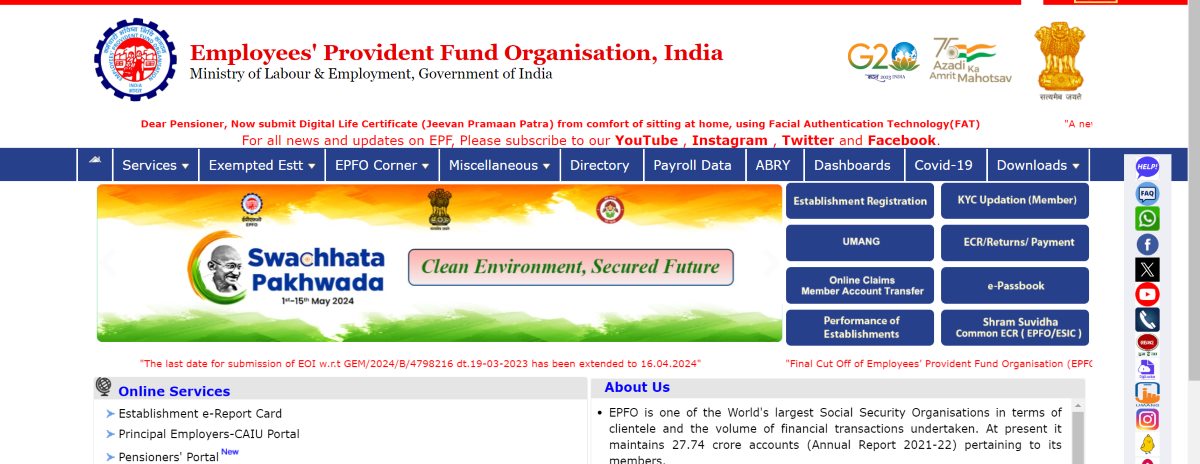
Sign Up With Unified Shram Suvidha Portal
Step 1: The USSP (Unified Shram Suvidha Portal) sign-up page can be accessed by clicking the "Establishment Registration" button on the EPFO homepage. The employer must click the "Sign Up" button.
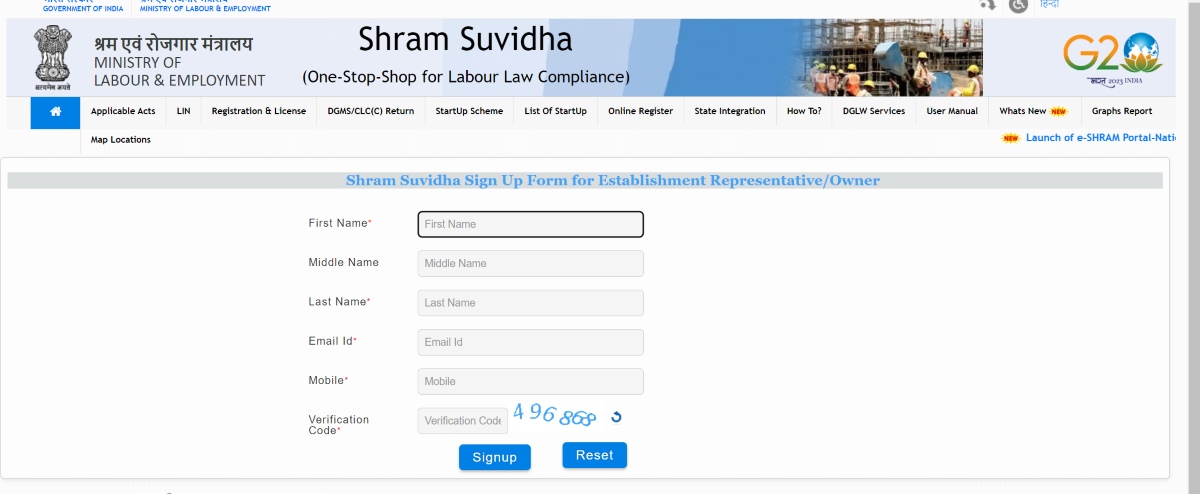
Step 2: To create an account, the employer must click the "Sign Up" button and provide their name, email address, mobile number, and verification code on the following page.
Enter the USSP and Login
Step 1: The employer must log in to the USSP after creating an account and click the "Registration for EPFO-ESIC'' button, which is located on the left side of the screen. Next, click the button on the right side of the screen that says "Apply for New Registration."
Step 2: The two possibilities are the Employees' Provident Fund and Miscellaneous Provision Act of 1952 and the Employees' State Insurance Act of 1948. After choosing the "Employees' Provident Fund and Miscellaneous Provision Act, 1952," the employer must press the "Submit" button.
Complete the Registration Form
Step 1: The employer must fill out every section of the "Registration Form for EPFO" page that opens after hitting the "Submit" button.
Step 2: After completing the "Establishment Details" box, press the "Next" button.
Step 3: Complete the fields in the "eContacts" section and press the "Add" button. Click "Next" once the details have been added.
Step 4: To add the address, use the "Add/Edit Address of Primary Manager" button in the "Contact Person" column.
Step 5: After selecting the "Add" button and providing the "Other Contact Person" information, click "Next."
Step 6: Enter the necessary information in the "Identifiers" section and press the "Add" button. Click "Next" once the details have been added.
Step 7: Please proceed to the next step of the registration form by entering the "Employee Details" area and clicking the "Add" button to input the details.
Step 8: After entering the information in the "Branch/Division" area, press the "Add" button. Click "Next" once the details have been added.
Step 9: Enter the NIC code, principal business activity, type of work, and subcategory of nature of work in the "Activities" box, then click the "Next" button.
Step 10: Click the "Upload" and "Save" buttons to upload each of the necessary document attachments to the "Attachments" section.
Step 11: A summary of the registration form will be displayed. After verifying the information provided in the registration form, press the "Submit" button.
Connect DSC
Step 1: Attach the digital signature certificate after selecting the "Digital Signature" button on the following page.
Step 2: The employer will receive a notification indicating that the registration form has been completed after uploading their DSC.
Step 3: The Unified Shram Suvidha Platform will also send the employer an email confirming the completion of the EPFO registration.
How can Employees Login to EPFO Portal?
Entering the EPFO portal is a relatively straightforward process. To finish the login process, you must input the password, captcha, and Universal Account Number (UAN).
Employers can access the EPFO site by following the instructions listed below to log in:
Step 1: Go to the EPFO website.
Step 2: Select the "For Employees" option after navigating to the "Services" section.
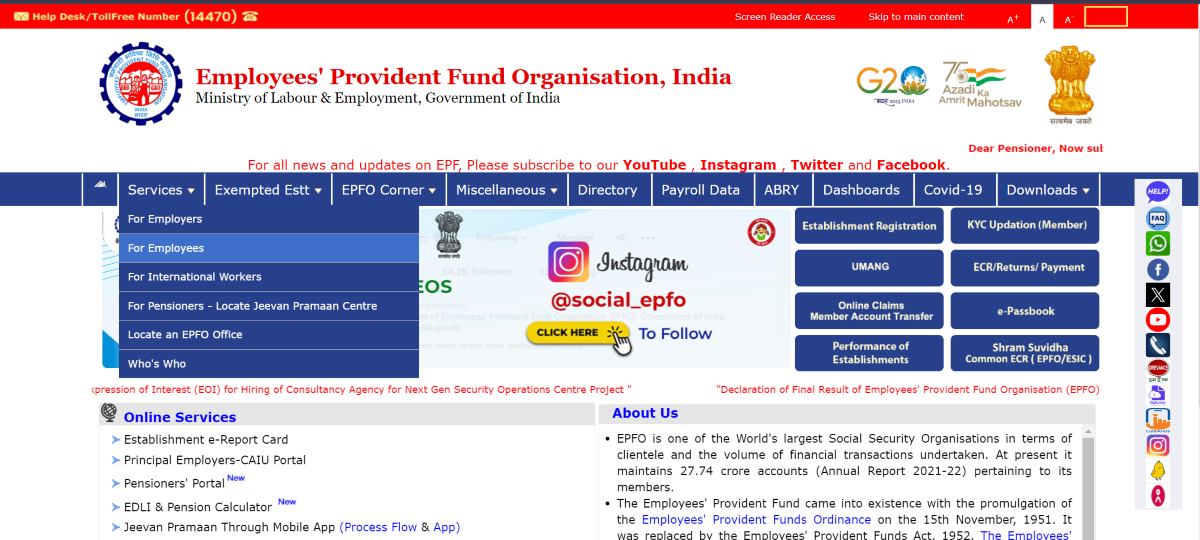
Step 3: You'll see a fresh dashboard. Select the "Member UAN/Online Services" section from the "Services" section.
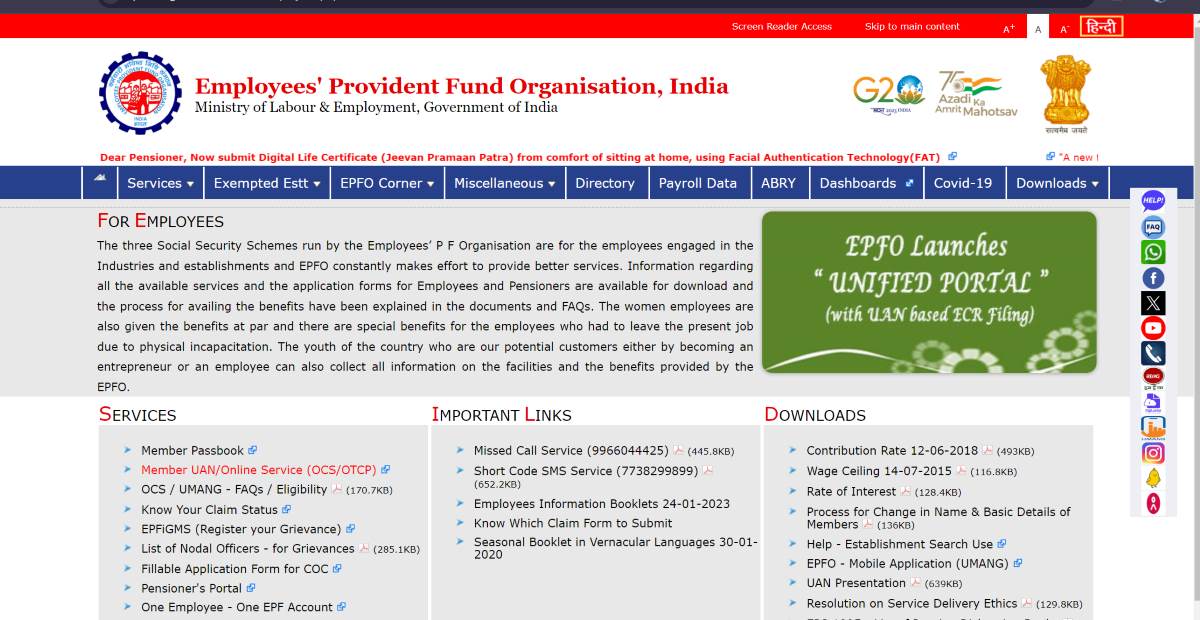
Step 4: To log in, use your UAN. Click on the 'Activate UAN' option if your UAN isn't activated.
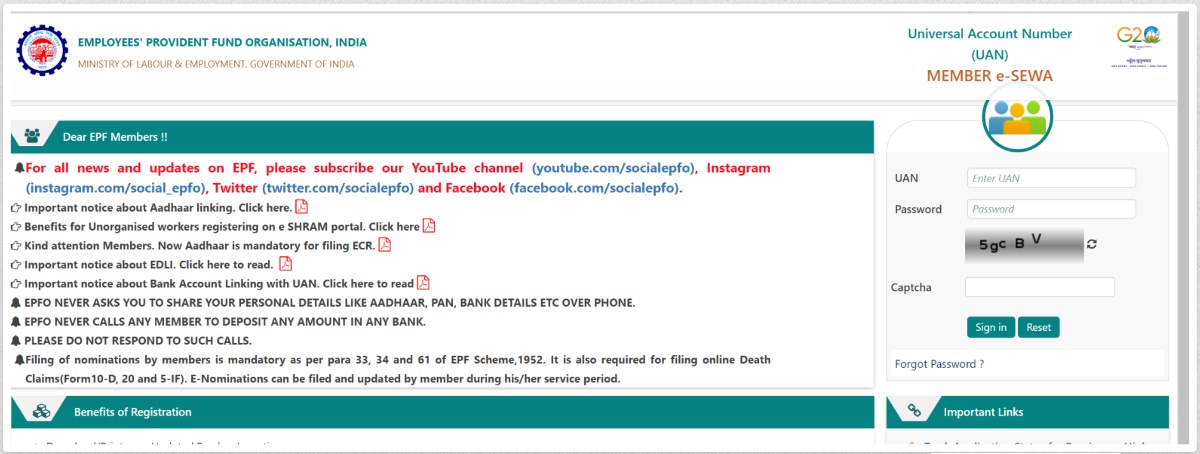
Step 5: After your UAN has been activated, you can log into the EPFO member portal whenever you like to check your PF balance, the status of PF settlements, and the status of partial PF withdrawals.
What are the Different Types of EPF Forms?
Employees' Provident Fund Organization (EPFO) members are eligible for EPF, EPS, and EDLI benefits. However, a member must use particular forms to communicate with EPFO for some purposes. The list of EPF forms and their purposes is provided below:
How to Transfer EPF Online?
To make an online Provident Fund transfer, please follow these steps:
Step 1: Log in to the EPFO website using your password and Universal Account Number

Step 2: Choose "One Member - One EPF Account (Transfer Request)" from the "Online Services" option.
Step 3: Determine whether you can move the PF amount to a different account.
Step 4: Enter the information about your former job, such as the name, account number, and registration state.
Step 5: Verify your prior employer's information and the PF account number.
Step 6: Enter your current employer's information here, including the name, account number, and registration state.
Step 7: Verify your current employer's information and the PF account number.
Step 8: Verify all the information you put in the form, then click "Get OTP."
Step 9: Enter the OTP sent to the registered phone number.
Step 10: Start the transfer request by clicking the "Submit" button.
Your transfer request will be assigned a tracking ID that you may use to monitor its progress. The PF balance ought to appear in your current employer's account a few days after the transfer is started.
What Happens to EPF if You Change the Company?
If you change jobs from one organisation to another EPFO-registered company, a new PF account will be added to your UAN. Through the UAN member e-sewa portal, you can submit an online request to transfer the current EPF balance from your old account to your new one.
However, to use EPF services online, you must ensure that your UAN and UID are connected. Your EPS fund transfer is completed concurrently with the transfer of your PF balance, but it won't appear on the web portal.
How to Link an EPF Account With Aadhaar Online?
Here are the steps to link an EPF (Employee Provident Fund) account with Aadhaar online:
Step 1: Visit the EPFO (Employee Provident Fund Organisation) website.

Step 2: Log in to your EPF account using your credentials.
Step 3: Navigate to the 'Manage' section on the dashboard.
Step 4: Select the 'KYC' option from the menu.
Step 5: Choose 'Aadhaar' as the document type you want to link.
Step 6: Enter your Aadhaar number and name as per Aadhaar.
Step 7: To proceed, click the 'Save' or 'Submit' button.
Step 8: A confirmation message will appear, indicating successful linking.
Interest Rates on Employee Provident Fund (EPF)
How is Interest Calculated on EPF?
Here's how to calculate EPF interest. Contributions to this Employees' Provident Fund are made monthly. However, the interest is calculated at the end of a year.
An interest rate of 8.15% is divided monthly, and that amount is paid to the employee. Therefore, monthly interest is 8.15%/12 = 0.6792%.
For a running balance of ₹6000, the interest calculated per month is shown below:
EPF Interest = Running balance for the month*0.6792/100%
Above was the EPF calculation for the years 2023-24.
How to Calculate EPF Contribution - Formula?
The formula to calculate EPF (Employee Provident Fund) contribution is:
Employee's contribution = Basic salary * Employee's EPF contribution rate
Employer's contribution = Basic salary * Employer's EPF contribution rate
Total EPF contribution = Employee's contribution + Employer's contribution
What is an Employee's Contribution Towards EPF?
Employees' contribution to the EPF (Employee Provident Fund) is typically a fixed percentage of their basic salary. As of my last update, the employee's EPF contribution rate is 12% of their basic salary.
However, checking with the latest regulations is essential, as contribution rates may vary based on government mandates or organisational policies.
What is an Employer's Contribution Towards EPF?
The employer's contribution to the EPF (Employee Provident Fund) is typically a fixed percentage of the employee's basic salary. As of my last update, the employer's EPF contribution rate is 12% of the employee's basic salary.
However, like the employee's contribution, it's essential to verify the current rates, as they may be subject to change based on government regulations or company policies.
What are the Categories of Employer's Contribution to EPF?
The employer's contribution to EPF (Employee Provident Fund) is divided into two categories:
1. Employee Provident Fund (EPF): The employer makes the main EPF contribution, which is 3.67% of the employee's basic salary.
2. Employee Pension Scheme (EPS): A portion of the employer's contribution (8.33% of the employee's basic salary, subject to a maximum of ₹15,000) is allocated to the EPS, which provides a pension to employees after retirement.
How to Withdraw EPF Money?
To withdraw EPF (Employee Provident Fund) money, follow these steps:
Step 1: Visit the EPFO (Employee Provident Fund Organisation) website.
Step 2: Log in to your EPF account using your credentials.
Step 3: Navigate to the 'Online Services' section.
Step 4: Select the 'Claim' option from the menu.
Step 5: Fill out the EPF withdrawal form online with the necessary details.
Step 6: Submit the form electronically.
Step 7: Once the form is processed and approved by your employer, the EPF amount will be credited to your bank account linked with your EPF account.
Alternatively, you can withdraw EPF money by submitting a physical withdrawal form to the EPFO office or through your employer. Ensure to provide all required documents and follow the specific withdrawal process outlined by the EPFO.
Who can Withdraw and When to Withdraw PF Money?
EPF (Employee Provident Fund) withdrawal is permitted for the employee under certain conditions:
Employment Termination: If unemployed for over two months, you can withdraw the entire EPF balance.
Retirement: Upon reaching age 58, you can withdraw the entire EPF balance.
Medical Emergency: You can withdraw a portion of your EPF balance for medical treatment for yourself, your spouse, your children, or your parents.
Housing Loan Repayment: EPF can be partially withdrawn to purchase or construct a house or repay a housing loan.
Education: Partial withdrawal is allowed for higher education expenses for yourself, your spouse, or children.
Marriage: EPF can be partially withdrawn for the marriage of yourself, siblings, children, or dependent children.
Home Renovation: Partial withdrawal is allowed to renovate your house.
After Five Years of Continuous Service: Partial withdrawal is allowed for specific purposes after completing five years of continuous service, such as home purchase, construction, or loan repayment.
The specific conditions and eligibility criteria for EPF withdrawal may vary based on the regulations set by the EPFO. Therefore, verifying the current rules and procedures before applying for withdrawal is essential.
What are EPF Tax Rules?
EPF is an EEE tax rule. Therefore, it is exempt from tax on EPF withdrawal. Further, contributions and interest received are also exempt from tax. However, there are some cases where EPF is taxable. These are:
It is taxable if an employer's contribution to the Employees' Provident Fund exceeds ₹7.5 lakhs in a financial year. An employee is liable to pay tax on an amount that exceeds ₹7.5 lakhs.
If an excess contribution from the Employee's side to the EPF account exceeds ₹2.5.
If there is no employer contribution to an EPF account, which is the case for government employees, then the interest will be tax-exempt up to ₹5 lakhs in a financial year.
Interest earned on inactive EPF accounts is taxable to the employees.
Withdrawal from the Employee Provident Fund account is tax-exempt except when withdrawal happens after less than five continuous years of service. And if any withdrawal amount exceeds ₹50,000, then TDS is applicable at 10%. However, withdrawals can be exempt in an employee's poor health, the closing of a business, or other events beyond the person's control.
How to Check EPF on the UMANG App?
To access EPF (Employee Provident Fund) on the UMANG (Unified Mobile Application for New-age Governance) app, follow these steps:
Step 1: Download and install the UMANG app from the Google Play Store or Apple App Store.
Step 2: Open the UMANG app on your mobile device.
Step 3: Register or log in to your account. If you're a new user, you must register by providing your mobile number and creating a password.
Step 4: Navigate to the 'All Services' section once logged in.
Step 5: Search for 'EPFO' or 'Employee Provident Fund Organisation.'
Step 6: Select the EPFO service from the list of services available.
Step 7: Choose the specific EPF service you want to access, such as viewing your EPF passbook, checking your EPF balance, or filing a claim.
Step 8: Follow the on-screen instructions to complete the desired action.
You should have your EPF account details handy, as you may need to provide them during the process. Ensure that your mobile number is linked to your EPF account for authentication.
Contact Information of the EPF Office
Employers can send their queries to employerfeedback@epfindia.gov.in.
Employees can send their queries to employeefeedback@epfindia.gov.in.
Moreover, you can also call the toll-free EPFO contact number, 1800118005.
For more information on contacting the Employee Provident Fund, you can use these links:
EPF Grievance Process
Here are the steps involved in the EPF Grievance Process:
Step 1: Registration: Visit the EPFi GMS (EPF Grievance Management System) portal and register yourself with your mobile number.
Step 2: Lodging Grievance: Fill out the grievance form with details like the EPF account number, name, address, and nature of the grievance.
Step 3: Submission: Submit the grievance form electronically through the EPFiGMS portal.
Step 4: Acknowledgement: You'll receive an acknowledgement receipt with a unique registration number for tracking purposes.
Step 5: Processing: EPFO officials will review your grievance and take the necessary actions to resolve it.
Step 6: Resolution: You'll receive updates on the status of your grievance through SMS and email. Once resolved, you'll be notified of the outcome.
Step 7: Feedback: Provide feedback on the resolution process to help improve EPFO's services.
Step 8: Escalation: If you are unsatisfied with the resolution, you can escalate the grievance further within the EPFO system.
Following these steps ensures the systematic handling of grievances related to EPF-related matters.
Comprehending the significance of the EPF scheme in India is important for both employers and employees. This scheme serves as a crucial financial safety net, and familiarity with the diverse EPF forms is essential for managing and accessing funds effectively.
In summary, the EPF is a valuable investment avenue for individuals saving for retirement. Its triple-exempt status ensures that withdrawals, interest, and contributions remain tax-exempt, making it a preferred choice among salaried workers.













